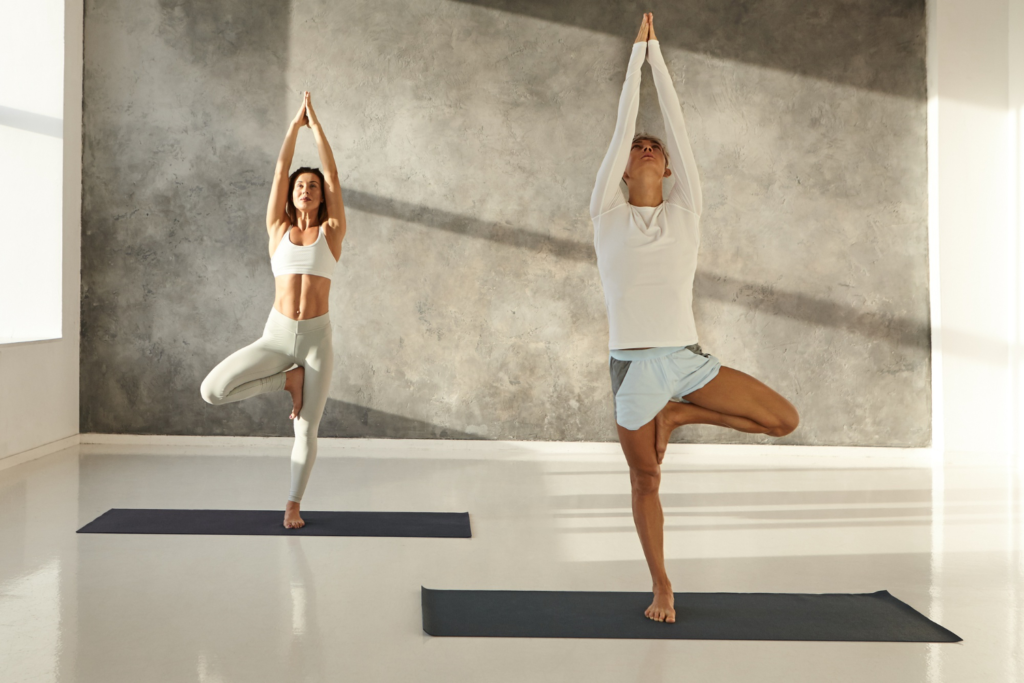Within the realm of yoga, there exists a multitude of asanas offering physical advantages as well as mental and emotional well-being. One such asana is Vrikshasana, also known as the Tree Dog Pose. This unique pose combines the stability and strength of a tree with the flexibility and grace of a dog, creating a harmonious balance between mind and body. In this blog post, we will delve into the intricacies of Vrikshasana, exploring its benefits, variations, and the steps to practice it correctly.
Vrikshasana, originating from the Sanskrit terms “vriksha” for tree and “asana” for pose, represents a standing balance posture mirroring the steadfast and rooted essence of a tree. This pose entails balancing on one leg while bending the other leg and positioning it against the inner thigh of the standing leg. The arms are extended overhead, mimicking the branches of a tree stretching toward the sky.The Tree Dog Pose combines elements of strength, balance, and focus, making it an excellent practice for both beginners and experienced yogis.
Benefits of Vrikshasana:
- Improved Balance and Stability: Vrikshasana tones and fortifies the muscles in the legs, ankles, and feet, crucial for sustaining equilibrium. Regular practice of this pose helps improve stability and coordination, making everyday activities easier and reducing the risk of falls.
- Increased Focus and Concentration: The Tree Dog Pose requires concentration and focus to maintain balance. By directing your attention to the present moment and the alignment of your body, Vrikshasana helps calm the mind and improve mental clarity.
- Enhanced Flexibility: As you bend and lift your leg to place it against the inner thigh, Vrikshasana stretches the hips, groin, and inner thighs. Consistent practice can progressively enhance flexibility in these regions, enhancing overall mobility and averting muscle imbalances.
- Strengthened Core and Leg Muscles: The act of balancing on one leg engages the core muscles, including the abdominals and lower back. Additionally, the standing leg works to support the body’s weight, strengthening the muscles in the legs, particularly the quadriceps and calves.
Variations of Vrikshasana:
Modified Vrikshasana: For beginners or those with limited flexibility, the pose can be modified by placing the foot against the calf instead of the inner thigh. This modification provides a stable base while still reaping the benefits of the pose.
Extended Arms Variation: To deepen the stretch and challenge the balance further, you can extend your arms out to the sides, resembling the branches of a tree. This version activates the shoulder and upper back muscles, encouraging improved posture and alignment of the spine.
Half Lotus Variation: For advanced practitioners, the Half Lotus Variation involves placing the foot of the bent leg on the upper thigh of the standing leg, with the toes pointing towards the floor. This version amplifies the hip stretch, demanding increased flexibility and balance.
Steps to Practice Vrikshasana:
- Start by standing upright, with your feet separated hip-width apart and your arms relaxed by your sides
- Shift your weight onto your left foot and raise your right foot from the ground.
- Bend your right knee and position the sole of your right foot against the inner thigh of your left leg, being careful not to rest it directly on the knee joint.
- Find your balance and join your hands together in prayer position at your heart center.
- Slowly raise your arms overhead, keeping your shoulders relaxed and away from your ears
- Fix your gaze on a point in front of you to help maintain balance and focus
- Hold the pose for 30 seconds to 1 minute, breathing deeply and evenly
- Release the pose by lowering your arms and bringing your right foot back to the ground
- Repeat the same steps on the opposite side, balancing on your right foot
Vrikshasana, the Tree Dog Pose, offers a lot for both the body and mind. By incorporating this asana in your life, it shall improve your balance, increase focus, enhance flexibility, and strengthen your core and leg muscles. Whether you are a beginner or an advanced yogi, Vrikshasana can be modified to suit your level of flexibility and challenge.

